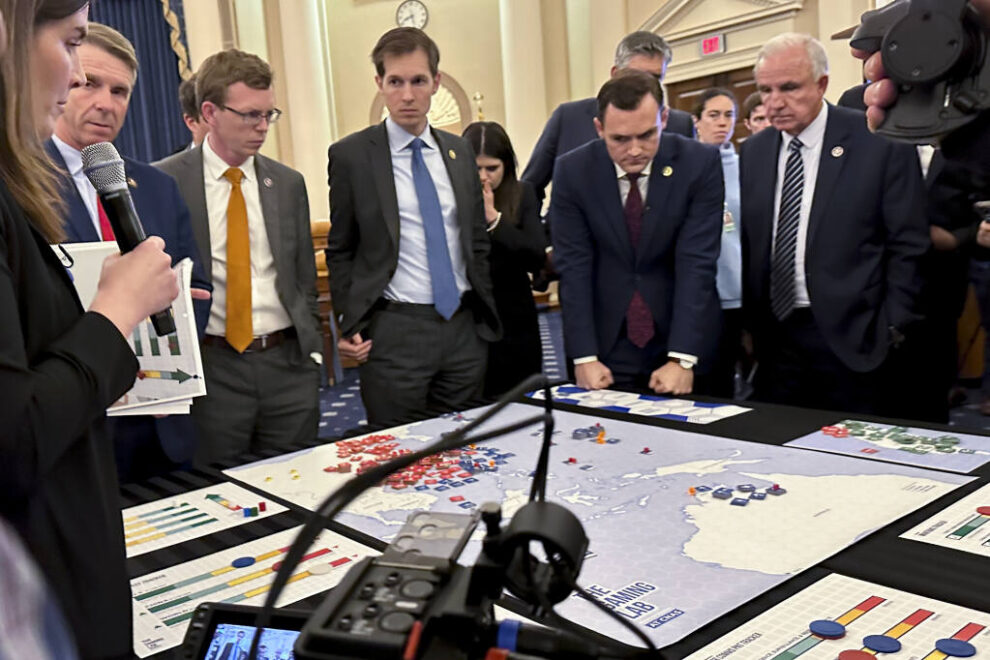MARINE CORPS BASE QUANTICO, Va. —
Three years into Force Design 2030, the United States Marine Corps has evolved into a leaner, more agile force designed to fight and win against the nation’s stated adversaries, with a strategic focus on the Indo-Pacific.
Aligning with the Department of Defense’s strategic pivot away from the Global War on Terrorism, this transformation relies not just on technological advancements and a structural reorganization but also on the strategic use of wargames—analytical tools used to simulate aspects of warfare at the tactical, operational, and strategic level.
Although wargaming has been integral throughout the Corps’ history, the initial call for wargaming modernization came from Gen. Robert Neller, the 37th commandant of the Marine Corps, who envisioned a wargaming capability akin to a ‘holodeck’—an imaginative technology from Star Trek that enables individuals to engage in virtual reality scenarios.
In a perfect world, it would be like Jean-Luc Picard in “Star Trek.” I’d walk into the holodeck and I’d go, “Computer, Battle of Waterloo, 1812, Prussian army, I am in command, simulation — go.” That’ll be here one day.Gen. Robert Neller, the 37th commandant of the Marine Corps
“In a perfect world, it would be like Jean-Luc Picard in ‘Star Trek,’” Neller told reporters in 2017. “I’d walk into the holodeck and I’d go, ’Computer, Battle of Waterloo, 1812, Prussian army, I am in command, simulation — go.’ That’ll be here one day.”
Neller’s vision is predicated on decades of Marine Corps’ innovation by highlighting the need for exquisite technology and facilities to harness that innovation. Wargaming assists in transforming it into actionable data to inform requirements, provide analysis for live-force experimentation, and contribute to concept refinement.
Recognizing the importance of his predecessor’s vision, Gen. David H. Berger, the Corps’ visionary former commandant, called for the implementation of “an intensive program of iterative concept refinement, wargaming, analysis and simulation, and experimentation” in his first iteration of Force Design 2030.
Today, this vision of a data-driven future is coming to life aboard Marine Corps Base Quantico where Marine Corps Systems Command is currently constructing a state-of-the-art center for wargaming and analysis.
Recently named the “General Robert B. Neller Center for Wargaming and Analysis,” this 100,446 square foot facility will allow Marines of all ranks and billets to wargame repeatedly in a secure, centralized location. Managed by the Marine Corps Warfighting Laboratory, this revolutionary new capability is set to open its doors in 2025.
As noted in a previous article, this will provide a crucial asset to the joint force and senior leadership, filling a gap previously absent in the National Capital Region by facilitating wargame participation for joint, interagency, and multinational organizations.
Historical Context and Modern Applications
The Marine Corps’ relationship with wargaming began in the early 20th century and ramped up leading to the Second World War as the Corps rushed to build a force—and develop tactics—that would allow it to successfully storm enemy beaches in Europe and the Pacific.
For the purposes of this article, a wargame can be defined as the methodical re-creation of competitive or conflict scenario(s), excluding real military forces, where human decisions shape events.
Col. George Schreffler, director of the Wargaming Division at the Marine Corps Warfighting Laboratory, explained this in layman’s terms on a recent episode of the Equipping the Corps podcast where he discussed wargaming using board games like Risk or Dungeons and Dragons.
“Although we don’t use those exact games, the principle remains the same: utilizing probability tables and dice rolls to drive decision-making and interactions. It’s not about the specific results but rather the process of forcing decisions that mirror real-world scenarios.”
But wargaming isn’t all fun and games; it is a whole of Combat Development and Integration effort. According to Col. Ross Monta, portfolio manager for Command Element Systems, it’s “a practical tool that’s helping us build the future of the Marine Corps.”
Lt. Col. Wynndee Young, PM Wargaming Capability, added to the colonel’s insights, noting, “Wargaming is crucial at every step of the mission, from both a tactical and operational perspective. It’s a process that guides us in how to use our current capabilities to successfully execute the mission.”
Wargaming is also important because it allows Marine Corps leadership to justify its spending to Congress and the taxpayer.
“Wargaming serves as a robust validation tool for our force design and future spending. It’s how we provide Congress with concrete data, supporting our requests for specific capabilities. In essence, wargaming enables us to not only fine-tune our military strategy but also justify the resources needed to bring that strategy to life,” she added.
Contemporary Wargaming Scenarios and Challenges
Today, wargaming continues to shape the Marine Corps’ preparations for the future fight by simulating a range of scenarios across different theaters, helping hone the warfighter’s ability to navigate complex challenges with agility and precision.
“Many of our wargames delve into scenarios that tackle key Pacific challenges, probing how we’d navigate them amid a national security crisis,” said Tim Barrick, wargaming director at Marine Corps University. “Some cater to European contexts with precision, while others are intricately designed for the nuanced demands of the Pacific Theater. Ranging from tactical intricacies to expansive theater-level maneuvers, these games cover a broad spectrum. Most maintain the agility to adapt across theaters, enabling versatile exploration.”
As Marines stand ready to answer the call to arms, wargaming remains a pivotal tool in their arsenal, enabling them to innovate, adapt, and strategize for the unique challenges of modern naval expeditionary warfare in the global littorals.
“In preparation for the multifaceted challenges of the Indo-Pacific, wargaming is a practical tool that informs future operating concepts, what capabilities are needed and should be invested in, and operational decisions and planning,” said Monta. “Wargaming helps us break down complex military challenges into specific constraints and issues, while also allowing for insights into previously unknown issues that arise during the conduct of a game.”
The Future of Wargaming
As Force Design 2030 continues to drive the Corps towards the future, wargaming will continue to play a crucial role in the planning and development of the tactics and strategies that have allowed the warfighter to fight and win throughout American military history.
But wargaming in the 21st century seeks to involve more than a few officers huddled around a slab of cardboard. Heeding Gen. Berger’s call for modernization, MARCORSYSCOM is embracing bleeding edge technologies like artificial intelligence and cloud computing.
At Marine Corps University in Quantico, Virginia, we’re taking things like large language models, like ChatGPT, and incorporating them into the simulations.Joel Corrientes, subject matter expert at Marine Corps University
“At Marine Corps University in Quantico, Virginia, we’re taking things like large language models, like ChatGPT, and incorporating them into the simulations,” Joel Corrientes, a subject matter expert at Marine Corps University, told reporters at Modern Day Marine.
Similarly, the development of the Warfighting Cloud means that a digital library of wargames can be securely accessed from various locations and devices—greatly expanding the scope of the capability.
“The difference with the new Wargaming Cloud is the ability to expand wargaming opportunities beyond the classroom. This offers Marines access to a library of digital games on their own time and at their own pace,” Brig. General Maura Hennigan, Marine Corps University president, said in a statement last year.
As Force Design 2030 continues to guide the Corps’ modernization efforts, wargaming stands as an indispensable asset, helping to refine our strategies, validate our tactical approaches, and prepare us to face the intricacies of an ever-changing global landscape.
With the United States calibrating its strategic compass toward the Indo-Pacific, the role of wargaming transcends mere planning— rather, it has evolved into a key pillar, serving to shape strategy and fortify operational excellence.
As we continue to navigate the changing currents of great power politics, MARCORSYSCOM’s wargaming capability will help ensure that the warfighter remains agile, focused, and above all, prepared to fight and win in any clime or place.
Sourch : Marines










